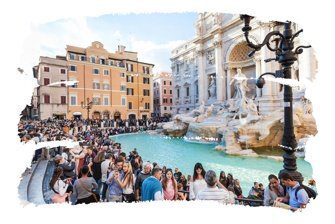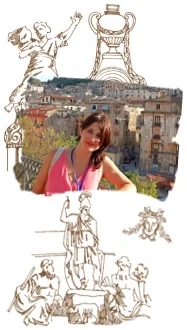Why do Italians gesticulate a lot?
Italians split many opinions and generate the feeling of “all or nothing”: either you love them, or you hate them! There is no middle ground when it comes to them. Italians speak loudly, gesticulate, laugh loudly and when they are angry then: mamma mia! Help! Hahaha… The fact is: if you grew up in a family of Italian descent, you are probably used to having 30 people at the table talking about all matters at the same time and, impressively, everyone gets along. If you grew up in a family, so to speak, “normal”, you will find the Italian way a little strange. But why do Italians gesticulate? Here at Your Travel to Italy with Ana Patricia you make the trip of your dreams!!! ALSO: see our “Accommodation in Italy – Tips for your holidays!”
Introduction
It is important to remember that IT IS CULTURAL! It’s not something they do on purpose, it’s just their way. For those who are not used to it, it may seem impolite, inelegant and even a little rude, but after you get to know them better and know how generous and kind they are, your ‘pet peeve’ will surely pass (Lol) Read also Experience Tourism in Italy!
1) Why do Italians gesticulate a lot? BECAUSE THEY NEED TO EXPRESS BETTER
According to some studies, Italian gestures exceed 250! Well, there are some explanations for that. We will see some of them below.
Commercials
The first one says that they gestured for commercial reasons. As they did not speak other languages and the distant traders did not speak Italian, they made buying and selling gestures.
Coded Language
The second one: the desire not to be understood by the predominant populations like the Romans, Goths, Normans and all the other peoples that dominated the peninsula. In this way they ‘created’ gestural communication. The gestures ended up replacing the spoken word as a kind of coded language that only they understood.
Body language
Another very plausible explanation: Italians are outgoing, communicative and people with these characteristics ‘speak’, also, through body expression, especially with their hands. The hands that ‘fly’ back and forth and look like they’re going to drop something all the time, follow their agitated personality. They say that if you tie the hands of an Italian, he is speechless! It is well known that Italians have unique and characteristic gestures to communicate.
Roman Empire
There is also a theory that it all started in the Roman Empire: whenever the emperors made their speeches, the people, to make fun or to imitate them, repeated the gestures of the sovereigns and, thus, the ‘gestural culture’ passed from generation to generation! There is another version of this same story that says that the people imitated plays, ‘repeating’ the gestures of the actors.
Understanding the dialect
One more theory: make one understand the other’s dialect! Italy is full of dialects, each region has a different one, and some of them, like Sardinian, are considered foreign languages. To avoid possible misunderstandings, they say that the gestures were ‘universal’: everyone understood independently of the dialect spoken by them and this facilitated negotiations between the different regions and peoples.
Amphitheater Signage
There is also the story that gestures were used in amphitheaters to signal, authorize, give or refuse orders, since the noise was deafening within the arenas and there was no way to communicate either close or ‘at a distance’, so , gestures were the best way to ‘send a message’.
2) Why do Italians gesticulate a lot? GET TO KNOW SOME CURIOSITIES
Now we will present some curiosities for you.
Prayer with United Hands
The story of another universal gesture is also interesting: prayer with united hands. It is the gesture of prayer par excellence and in many religions the gesture is repeated. The image refers to believers before Christ and mothers in front of the miserable son. In reality, the origin of the gesture is not religious, as one might think, but it has a noble origin. The frescoes in the catacombs instruct us that during the first centuries of Christianity they prayed standing and with open arms, as priests still do during Mass. The other ancient form of prayer was face-down prayer (think of Jesus in the garden of Gethsemane or the Muslim way of praying).
The prayer, as we know it today, the one with united hands, had derived from the act of a feudal homage. During the ceremony, the vassal, on his knees, put his hands in the hands of the feudal lord and promised him loyalty, in addition to securing his services in exchange for protection and support. Thus, the knight gave his life to the hands of his master and became one of his men (from the Latin homo from which homagium comes, homage). Read also What is the best route to go to Italy for the first time?
New York Times article
The New York Times made an article talking about Italian gestures and spoke of gestures as follows: “It is a succession of undeniably significant movements, in which it is not difficult to find some of the habits of all of us: from four fingers to the thumb to say ‘what you are saying, on the back of the hand it passed under the chin to say unequivocally that ‘I don’t care about that’ ”.
But where does this fame come from?
Much of this fame of the Italians ended up abroad and that was because of the gestures made by celebrities and, in particular, by representatives of the Italian political class. Also in the New York Times article, in fact, some gestures of public figures are revised, which for better or for worse, have fallen into history. The article includes the iconic middle finger episode shown by Umberto Bossi in 2008, during the performance of the Italian anthem and goes through the gesture of physical appreciation made by former Italian Prime Minister Silvio Berlusconi to Michelle Obama, former US First Lady at the 2009 G20 meeting.
According to Isabella Poggi
According to Isabella Poggi, professor of Psychology at the University of Rome, “there are gestures that express threat, desire, despair, shame and pride, among so many other feelings”. According to the psychologist what differentiates them from sign language is that they are used individually and do not have a complete syntax.
The philosopher Giambattista Vico
The philosopher Giambattista Vico defended the thesis that gestural communication took place in the most distant times, as in prehistory, since there are no records of verbal communication and, in addition to gestures, sounds were used that today would not make any sense.
(Source: The New York Times)
Did you know?
- And, for those who HATE the fact of speaking with their hands, I have a very ‘boring’ news: the origin of our body language and our way of speaking is ALL Italian! So, before ‘condemning’ Italian friends, remember this information!
- Other gestures that the Italians created: the middle finger, if we stop to think, there is no problem in showing someone a finger, but the middle finger. It is said that Emperor Caligula, who ruled Rome from AD 37 to 41, used to put a ring on his middle finger and make his subjects kiss him as a form of humiliation, since the upward finger resembled an erect penis.
- But as not everything is as bad as it seems, Italians are also responsible for waving their hands to say goodbye, slapping their hands against their stomachs to say they are hungry, closing their hands with their thumbs extended towards their mouth to invite someone to drink, and another VERY well-known Italian gesture: close your hand and rock it back and forth, slightly, with your fingers together to show dissatisfaction.
Conclusion
Why do Italians gesticulate a lot? The loud chatter, the laughter and the gestures, make the Italian people unique in the world and even with that ‘askew’ way, they are incredible! Leave any and all prejudice aside and LIVE the Italians: get to know them, try to get involved in this lively and exaggerated environment; above all: understand that nothing will change them and respect them, always!
If you feel insecure, have no time, and need help to organize your trip, don’t hesitate to contact me! I will love to help you make your dream trip to Italy come true. And how can I do that? Keep reading this post until the end and you will understand how we make your life and your trip much easier.
Did my post help you? If so, be sure to post your comment below, but if you still have questions just send me a message I will answer you as soon as possible!
An Extra Help for your Trip
The best content from Your Travel to Italy!
Learn more about our tours in Italy right now!
- What to visit in Italy in 10 days?
- The ten must-see places in Tuscany?
- The best tips to save on your trip to Italy?
- What are the 10 most visited cities in southern Italy?
- Airports in Italy? How to get to your hotel? (Venice, Milan, Rome, Florence)
- What to do in 1/2/3/4 days in the main Italian cities?
- The best tips on food in Italy (wines, typical food, enogastronomy tours)
- How to get from Fiumicino Airport to Rome downtown?
- Your Travel to Italy: 10 tips for traveling through Italy!
Best regards from Italy





 Save money!
Save money!